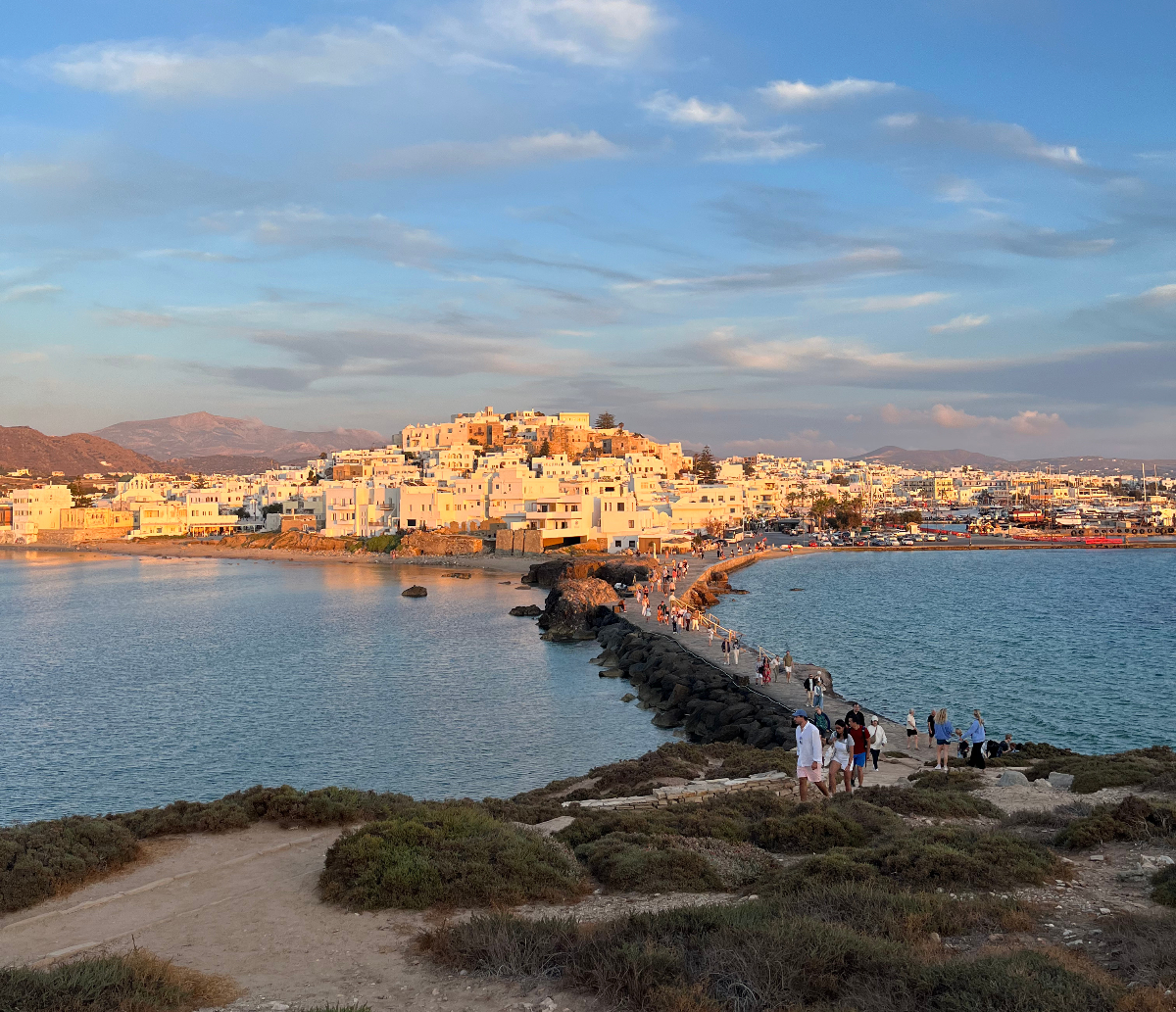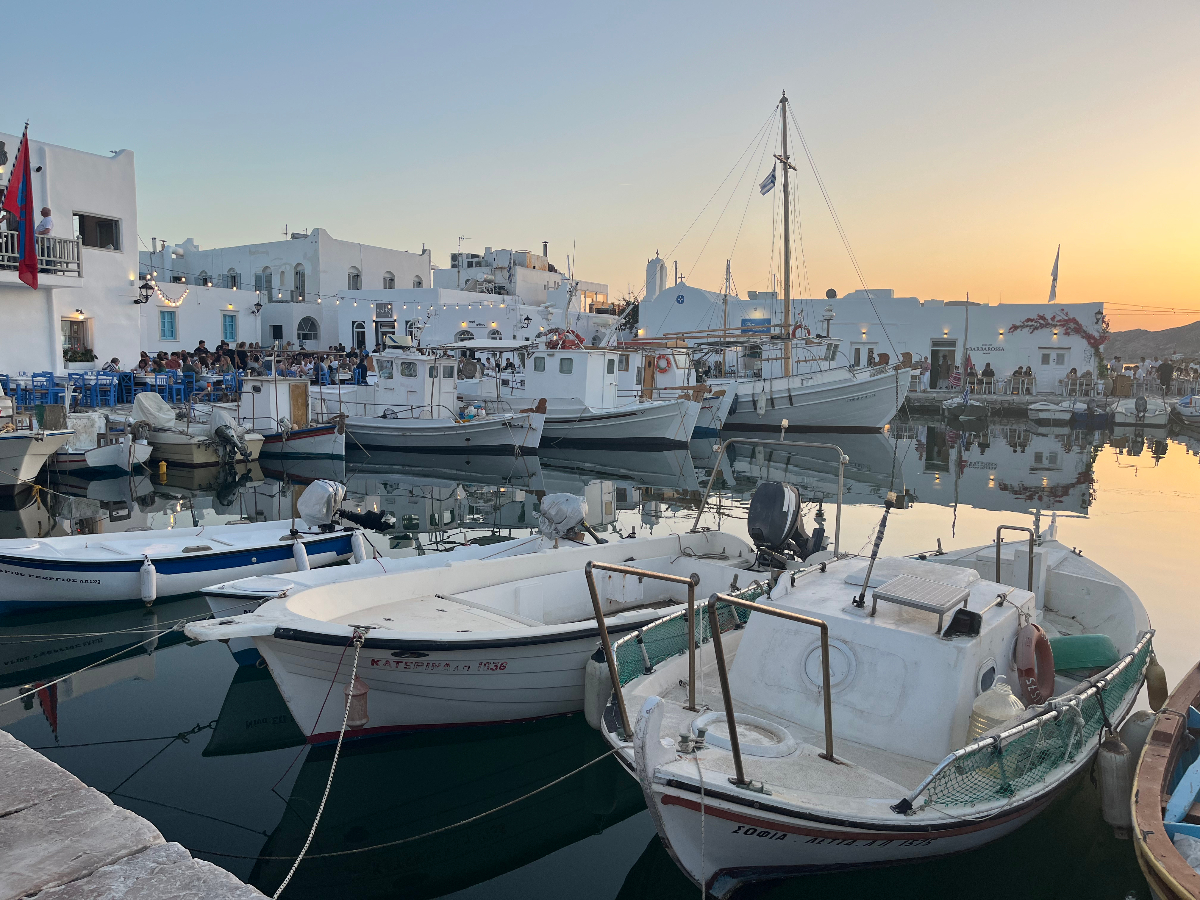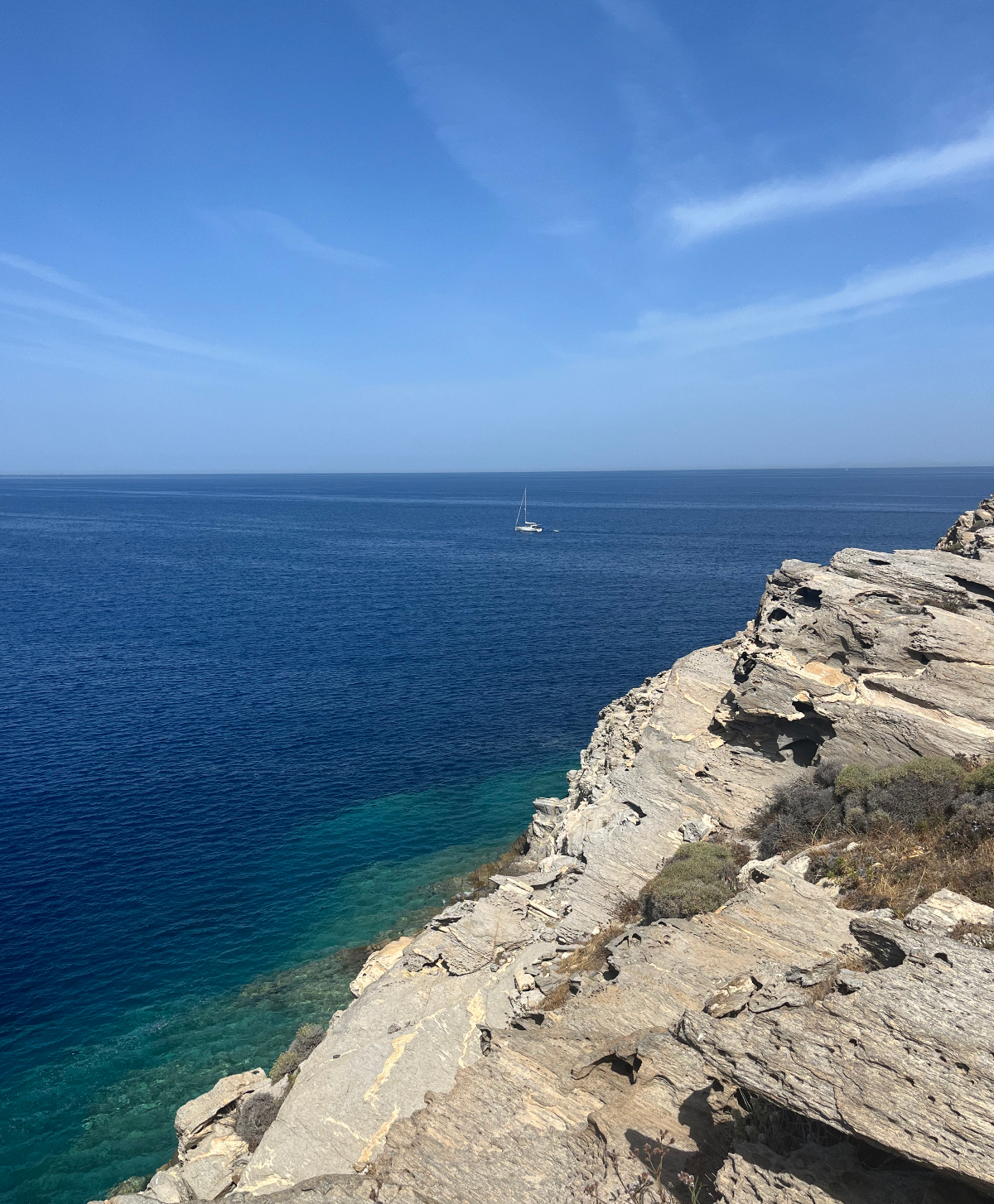Slow Travel and Authentic Charm on Naxos and Paros
- November 25, 2024
- 12 Min Read
If I had to design the perfect Greek isle from scratch, it would look a lot like Naxos and Paros. Blue-domed churches and whitewashed villages? Check. Golden beaches lapped by turquoise waves and countryside lush with olive groves? Covered. Cute waterfront tavernas at which to feast on the day’s catch? They’re here too. And while all of this may sound like a recipe for tourism run amok, it’s exactly the opposite — the streets are still full of local farmers, fishermen and artisans, and traditions are respected, not just preserved for show. These are island experiences rooted in the real Greece instead of the Instagram version.
Less than an hour apart by boat, Naxos and Paros are a seamless pairing for a laid-back Greek island getaway. You can get a taste of both in a week, though 10 days is ideal if you want to venture off-path and move at a more leisurely pace.

Guide to Visiting Naxos and Paros
Naxos
As the biggest and most mountainous island of the Cyclades, Naxos’ allure lies in its diversity — a blend of postcard-perfect beaches and pine thickets, weathered ruins and spreading farmland, vibrant coastal towns and sleepy hillside hamlets. It’s the Greece most travelers picture, yet the island remains fundamentally rural and deeply connected to local customs. Life in Naxos moves to the rhythms of the land and sea, not the rush of the modern world, and you’ll soon find yourself following suit.

Naxos Town
Naxos Town, a.k.a. Chora, serves as the island’s hub, home to the ferry port, rental car agencies, essential services and the greatest concentration of boutiques and restaurants. The old town at its core is a picturesque maze of Cubistic white buildings, narrow cobblestone lanes and brilliant pink bougainvillea tumbling over the walls. This is the one area that tends to heave with tourists in high season, but you can easily find breathing room amid the back alleys, accompanied only by the feral cats that wander at will.
I recommend engaging a private guide for a walking tour to get a picture of Naxos’ complex history and its prominent role in Greek mythology (legend has it this is where both Zeus and his son Dionysus grew up). Must-sees include the Kastro, a 13th-century Venetian castle that houses the Archaeological Museum of Naxos; a handful of storied Orthodox and Catholic cathedrals; and the Portara, an ancient marble gate that stands amid the ruins of a temple. It’s prettiest as evening falls, and a steady stream of visitors head there to watch as the sun sinks behind it.
TIP: Chora makes an ideal home base if you want to be within walking distance of in-town amenities, and a number of the island’s toniest resorts are clustered in this area. The tradeoff is that convenience comes with increased noise and traffic. Opt for a beach resort farther down the coast or an inland villa if you prefer a more serene ambience. Our Travel Advisors can help you choose and book the right property for your needs.

Beaches and Water Activities
You can’t swing a (feral) cat without hitting a beautiful stretch of sand. The best of Naxos’ abundant beaches are strung along the western shore, starting with busy, buzzy Agios Georgios right on the edge of Chora. The farther south you go, the more peaceful and less populated the beaches become. Most are within a few minutes’ walk or drive of tavernas and bakeries and offer clusters of sunbeds you can rent for the day, though it’s fine to spread out your own blanket. Parking can be tight; it’s a good idea to arrive early and claim your little piece of paradise.
Naxos gets strong meltemi (seasonal winds that peak in summer), optimal for watersports like kitesurfing, kiteboarding, windsurfing and sailing. Its waters are rich with sea bream, swordfish, mackerel, tuna, snapper and dozens of other fish — charter a caique, or traditional Greek fishing boat, and cast your line with the help of a guide who knows the best spots.
TIP: Many of Naxos’ beaches are clothing-optional, so be prepared to see people swimming and sunning in the buff. If you’d rather avoid that, ask your hotel concierge about beaches where nudity isn’t allowed.

On the Ground
Idyllic villages are scattered across Naxos. Because of the vertiginous terrain, driving between them takes more time than you might expect, so it’s best to aim for no more than two or three in a day.
My favorite of all the villages we visited was Apollonas, a little fishing townlet on Naxos’ northeastern edge. Its crystalline water beckons swimmers in for a dip, and a handful of open-air restaurants cheek by jowl with the harbor serve simple, fresh Naxian fare. Apollonas is also home to the Kouros, a colossal unfinished statue of mysterious origin that dates to the 8th century.
Near Filoti, the largest village on Naxos, you can access the trailhead for the island’s signature hike: a 3.5-mile out-and-back route to Mount Zas, named after Zeus. The distance isn’t as challenging as the elevation — the trail is incredibly steep and strenuous with precarious footing in spots. It’s best suited for families with tweens and up who have the stamina to make it to the top, and you’ll want a supply of water and snacks. The payoff? Jawdropping vistas over Naxos and the Cyclades, immersed in such profound silence that you can hear the birds’ wings flap high above.

Make time to delve into Chalki, or Halki, which was once the capital of Naxos and contains well-preserved remnants of centuries past. Its pleasant main square is lined with cafes for idling over a coffee or a snifter of local kitron liqueur. From there, a path leads through the olive groves for which this area is known, ending at the 11th-century Byzantine church of Agios Georgios Diasoritis. Opening hours are quirky, so ask around in the village to make sure you’ll be able to access the interior and admire its beautiful frescoes.
We're here to make your vacation to Greece unforgettable!
Our expert Travel Advisors can design a custom itinerary, arrange private guides and experiences, and book vetted accommodations, often with valuable perks to pass along. Click for more details!

We stumbled on the village of Eggares en route from Chora to Apollonas, and it turned out to be one of our best finds. The Eggares Olive Press has been in owner Nikoletta Lianos’ family for five generations. She is delightful and available onsite most days to explain how oil was made with the vintage machinery displayed in the tiny museum. The highlight is the onsite tasting room and shop, where you can sample the various products crafted in-house: flavored olive oils, tapenades, marmalades and lots of other delicacies. Coffee, cocktails and nibbles are available too — be sure to try the olive oil cake made from a recipe handed down by Nikoletta’s grandmother, perhaps with a scoop of olive oil ice cream on the side.

Paros
In ancient times, Paros made its name as the home of Greece’s finest marble quarries (its stone was used for sculptures like the Venus de Milo and Winged Victory of Samothrace). You’d never guess its workaday roots, though, by the upscale beach clubs and posh resorts that have sprung up since. While Paros has a cosmopolitan sheen that’s absent from Naxos, you can find plenty of places where time seems to have paused — the farther you get from the two main coastal cities, Naoussa and Parikia, the quieter the island becomes, offering a welcome chance to slow the pace and ground yourself in local life.
Naoussa
To call Naoussa a fishing village doesn’t do it justice. It’s the loveliest and most elegant town on the island, and the brightly hued boats jostling in the harbor are surrounded by tavernas at which well-heeled diners crowd the tables that spill into the open square. Naoussa is less about sightseeing and more about savoring the atmosphere — it invites lingering over a glass of Parian wine as dusk gives way to darkness, or an afternoon of browsing the boutiques and art galleries for locally made mementoes to bring home.
Nestled in a gulf on Paros’ northern coast, the Naoussa area is convenient as a home base, as you can easily access a wide range of beaches plus towns farther inland. A crop of new luxury hotels and resorts has opened within the last few years, meaning you’re spoiled for choice — our Advisors can help you sort through all the options.

Parikia
If you’re coming to Paros by ferry, you’ll most likely arrive in the capital, Parikia (Paros Town). Although it doesn’t wow visitors at first blush in the way Naoussa does, get beyond the chaos and concrete monoliths of the port district and you’ll come upon a much more appealing tangle of narrow streets, vibrant shops and cozy cafés. I wouldn’t choose Parikia as a place to stay, but it’s worth a day of exploring.
The best attraction here is Panagia Ekatontapiliani, or the Church of the Hundred Doors. Erected in the 4th century and renovated by Roman emperor Justinian in the 6th century, it’s a patchwork of Paleo-Christian, Byzantine and post-Byzantine design that incorporates architectural fragments from ancient temples. Its name refers to a legend that there are 99 visible doors and a hundredth that will appear when the Hagia Sophia in Istanbul becomes Greek Orthodox again. The church is stunning inside, with lavish marble detailing, frescoes, wood carvings and gilded scrollwork.

Beaches and Water Activities
Paros is known for its pristine beaches (though it’s half the size of Naxos, it actually has more spots to enjoy the coast). There’s a beach for every personality, from the vibrant energy of Monastiri to the remote solitude of Langeri. Make a beeline for Kolymbithres, the most famous beach on the island, where the sculptural granite boulders that jut along the shore lend the look of a moonscape. Small pockets of sand are tucked between the rocks, and if you get there early enough to stake one out you might have it all to yourself. Water taxis run from Naoussa to Kolymbithres for those who don’t want to deal with parking.
If there’s a single activity not to miss here, it’s sailing — the day we spent on the water was our favorite day on Paros. Book a charter or a private tour so you can lie back, unwind and soak up the sea and sun. Ours included an enormous homemade lunch that our captain-turned-chef somehow produced from a pint-size onboard kitchen: rice cooked with cuttlefish; taramasalata spread; fresh octopus; Greek yogurt with macerated grapes; and lots of other treats, including cherry tomatoes from his garden and white wine from his vineyard. How’s that for local?
Although the exact route of your sail will depend on the meltemi, aim for one that visits both the Blue Lagoon, a vivid turquoise pool for swimming and snorkeling, and Antiparos, a small but enjoyable island just west of Paros. If you’re intrepid, there are sheer cliffs from which you can jump into the water along the way. Be warned, they’re higher than they look.
TIP: Antiparos has a single town, one main road and a handful of hotels and restaurants, but it’s a popular day trip from Paros as the ferry takes only 10 minutes. Its biggest sightseeing draw is Antiparos Cave, a stalactite- and stalagmite-laden expanse that descends almost 300 feet into the earth.

On the Ground
Like Naxos, Paros contains a smattering of traditional Cycladic villages to explore. The best known is medieval Lefkes, which is relatively untouristed and home to just 600 residents or so. It feels like a throwback to an earlier era, the perfect antidote if you need to escape the bustle of Naoussa in high season. Stretch your legs on the footpath that has led from Lefkes to the village of Prodromos for nearly a thousand years; the walk is about 90 minutes one way.
On our final morning on the island, we laced up our hiking shoes and headed for the Environmental and Cultural Park of Paros, an area created for outdoor recreation and arts events. The trail we chose took us up a moderate slope to the 19th-century Cape Korakas Lighthouse. You can’t go inside, but the vantage point over Paros from here is gorgeous — it was an extraordinarily satisfying way to say goodbye to this Greek gem.

Essential Naxos and Paros Travel Tips
When to Go
We visited Naxos and Paros in late May and early June. While that’s technically shoulder season, both islands were already hopping and the water was swimmable, if brisk (around 69° F). Visitors surge from late June through August, though not nearly to the extent they do on neighboring Santorini and Mykonos; this is largely because no cruise ships stop at Naxos and very few at Paros. If you have some flexibility, September is a fantastic time to go — the islands empty out yet the weather is still beautiful and the sea remains mild.
Getting There
Both Naxos and Paros are easy to access from Athens. You can either take a short direct flight or a ferry; two main ferry lines, the high-speed Seajets and the slower Blue Star, depart several times a day from Piraeus, the capital’s main port. Note, these are not luxurious experiences by any stretch, but they get the job done. Each vessel holds hundreds to thousands of passengers and is equipped with wifi, gift shops, cafes and snack bars.
On average, sailings from Athens to each island take anywhere from four to six hours. The trip between Naxos and Paros is much quicker, about 45 minutes. Ferry delays can build as the day passes, so book the earliest one possible.
TIP: If you’d like a bespoke transfer, our vetted Greek travel partner can organize a private sail from the mainland and/or between the islands, complete with a homemade feast and stops to splash in the sea. It’s a wonderful way to make the most of a day in transit.
Getting Around
While you can navigate Naxos and Paros reasonably well by public transport, I strongly suggest renting a car or hiring a driver. Part of the joy of these islands is letting your nose lead you, especially on Naxos — the peaks and valleys are laced with sharply twisting roads, and the way the views shift between tree-covered slopes and flashes of the sea below is magical. Having your own wheels also makes it much easier to access inland villages and rural areas.

Food and Drink
The tap water on the islands is desalinated seawater, which isn’t potable due to its bad taste (it’s fine for brushing your teeth or rinsing a dish). Most hotels will provide a supply of bottled water. In Naxos Town, public fountains spout pure spring water from the mountains, which Naxians collect for drinking. You can also pick up water bottles at supermarkets for very little cost, as the Greek government maintains strict price caps to prevent gouging — a good-size bottle is just €0.60.
As in much of southern Europe, mealtimes here are late. Lunch is usually between 1 pm and 3 pm, and dinner starts about 8:30 or 9 pm. Many restaurants begin serving earlier to accommodate tourists, so you won’t go hungry if that’s too long to wait.
Unsurprisingly, fresh seafood reigns in this area. Grilled whole fish of all kinds, octopus in multiple forms, marinated sardines and anchovies, cuttlefish, mussels and prawns are ubiquitous on menus. Rosto, slow-roasted pork in a rich tomato and wine sauce, is a Naxian favorite, usually paired with the delicious potatoes for which the island is known. Naxos is famed for its cheeses too, including nutty Graviera Naxou made in the style of Gruyère and the soft, tangy mizithra that’s often scooped onto salads.
Bakeries are plentiful on both Naxos and Paros, and they’re perfect for grabbing an inexpensive breakfast or lunch on the go, such as a slab of spinach pie or Greek baklava.
Things to Know
Mosquitoes can be a nuisance, particularly on Paros; local pharmacies carry ample supplies of bug spray and bite cream. You might find plug-in diffusers filled with repellent in your accommodations as well.
Some of the beaches on each island are rocky and sea urchins lurk in the shallows, so pack water shoes to protect sensitive soles. The sun is exceptionally strong — bring or buy plenty of sunscreen as well as a broad-brimmed hat and, if you burn easily, sun-protective clothing. If you’ll be spending lots of time outdoors in summer, consider a cooling towel as well. High temperatures in Greece are nothing to take lightly.
Relevant Links:
Browse all accommodations and activities in Greece on Ciao Bambino
Top Greek islands for families: How to choose the best match
72 hours in Athens, Greece with kids
A week in the realm of Greek gods: Visiting Crete with kids
Acropolis views at St. George Lycabettus Lifestyle Hotel
Photos by Lisa Frederick.
Editor’s note: This post was accurate when published. We advise checking independently for the latest information and updates. Ciao Bambino does not accept responsibility or liability for any errors or omissions in, or for any actions taken based on, the information presented.






 travel recommendations, inspiring adventures, and exclusive travel offers
travel recommendations, inspiring adventures, and exclusive travel offers